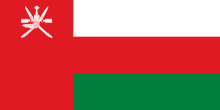 | |
| Total population | |
|---|---|
| c. 2.67 million | |
| Regions with significant populations | |
| 2,024[2] | |
| 390[2] | |
| 260[2] | |
| 149[3] | |
| 148[2] | |
| 24[2] | |
| Languages | |
| Omani Arabic (majority) · Standard Arabic · Mehri · Balochi · Swahili · Zadgali · Kumzari · Luri · Luwati · Persian · Urdu · Harsusi · Bathari · Dhofari Arabic · Shihhi Arabic · | |
| Religion | |
| Predominantly : Ibadi Islam, Sunni Islam | |
Omanis (Arabic: الشعب العماني) are the nationals of Sultanate of Oman, located in the southeastern coast of the Arabian Peninsula. Omanis have inhabited the territory that is now Oman. In the eighteenth century, an alliance of traders and rulers transformed Muscat (Oman's capital) into the leading port of the Persian Gulf. Omani people are ethnically diverse; the Omani citizen population consists of many different ethnic groups. The majority of the population consists of Arabs, with many of these Arabs being Swahili language speakers and returnees from the Swahili Coast, particularly Zanzibar.
Additionally, there are ethnic Lurs, Persians and Mehri. There are also Omanis from South Asia like the Lawatis, Zadjalis and others.[4][5] Moreover, in Dhofar, Sur and Muscat, Afro-Omanis can be found. They are the descendants of the slaves who were brought from Africa centuries ago.[6]
Omani citizens make up the majority of Oman's total population. Over one and a half million other Omanis live in other areas of the Middle East and the Swahili Coast. In 2023, an estimated percentage of 47.2% of Omani Muslims were Sunni Muslims and 35.2% were Ibadi Muslims while only 6.5% were Shia Muslims.[7]
- ^ "Monthly Statistical Bulletin: October 2019" (PDF). www.ncsi.gov.om. Archived from the original (PDF) on 21 October 2019. Retrieved 21 October 2019.
- ^ a b c d e "Country-of-birth database". Organisation for Economic Co-operation and Development. Archived from the original on 2009-06-17. Retrieved 2008-09-21.
- ^ Immigrants in Brazil (2024, in Portuguese)
- ^ "Oman's Diverse Society: Northern Oman" (PDF). JE Peterson.
- ^ "Oman's players of Pakistan origin caught in visa mix-up". 25 February 2016.
- ^ Valeri, Marc (2009). Oman: Politics and Society in the Qaboos State. Hurst. ISBN 978-1-85065-933-4.
- ^ "Oman - The World Factbook". www.cia.gov. Retrieved 2021-05-18.